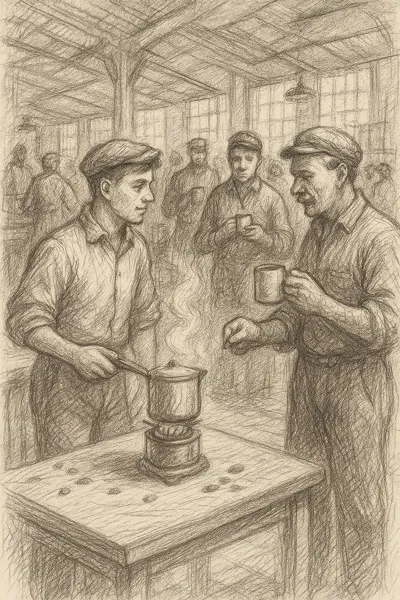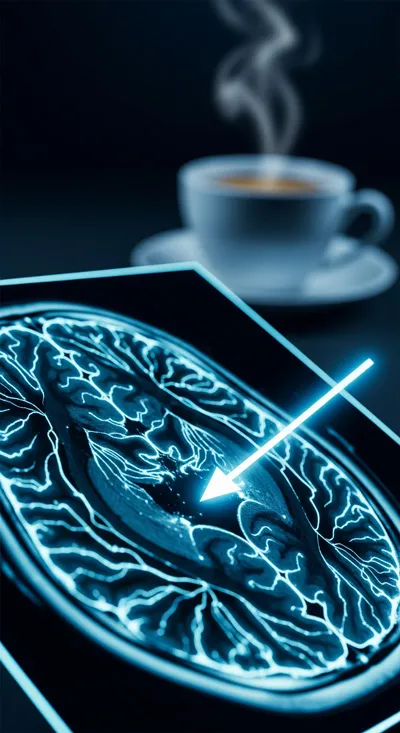If you’ve been drinking coffee for any length of time, you’ve probab...

This article was last updated on August 26, 2025 to include the latest information.
I used to feel guilty about my 10 AM coffee break. You know that nagging feeling that you should be working instead of standing around the office kitchen, chatting with coworkers while your coffee cools? I thought it was just procrastination with a caffeine excuse.
Then I discovered something that completely changed how I think about coffee breaks: they’re not just a nice workplace perk – they’re actually essential for how our brains learn and process information. MIT researchers found that our brains literally replay and consolidate experiences during breaks, and companies that figured this out over a century ago built empires on the productivity boost that strategic coffee breaks provide.
Turns out, feeling guilty about your coffee break is like feeling guilty about breathing. You’re not being lazy – you’re optimizing your brain.
The coffee break wasn’t invented by employees trying to avoid work – it was created by a boss trying to make his workers more productive.
In 1901, Italian factory owner Luigi Bezzera had a problem: his workers were taking too long on their coffee breaks. His solution was brilliant in its unintended consequences. Instead of banning coffee, he figured if he could make coffee faster, his employees would finish their breaks sooner. So, he invented the espresso machine.

Using steam pressure to force hot water through ground coffee, Bezzera created the first espresso – literally meaning “pressed out” or “express” in Italian. His goal was to speed up coffee breaks, but he accidentally launched an entire coffee culture that made breaks even more important to people.
Meanwhile, in Buffalo, New York, the Barcolo Manufacturing Company (which later became Barcalounger) made history in 1902 by officially adding coffee breaks to their employee benefits. Workers negotiated for short morning and afternoon breaks, with one employee volunteering to heat coffee on a kerosene hot plate.
The results were immediate: productivity increased, worker satisfaction improved, and other companies started copying the model.
Coffee breaks became so important that they almost caused a national economic crisis.
In 1964, the United Auto Workers union was negotiating with Detroit’s Big Three automakers, and coffee breaks became a major sticking point. UAW vice president Leonard Woodcock pointed out something embarrassing: “You have coffee breaks on assembly lines all over the world. Only the U.S. has no coffee breaks on the assembly line.”
The negotiations got so heated that 74,000 Chrysler workers were ready to walk off the job – not over wages or health insurance, but over the right to a 12-minute daily coffee break.
Time magazine covered the crisis, and Chrysler finally gave in with less than an hour before the strike deadline. The result? A 12-minute daily coffee break that became standard across American manufacturing.
That moment established coffee breaks as a worker’s right, not just a workplace nicety.

This is where the science gets fascinating.
MIT researchers wanted to understand how learning actually works, so they wired up rats’ brains and watched what happened as the rats learned to navigate mazes. What they found completely changed our understanding of learning and memory.
While the rats ran the maze, their brain cells fired in specific sequences. That wasn’t surprising. But here’s the amazing part: during breaks immediately after learning, those exact same brain cell sequences replayed – in reverse, at twenty times normal speed.
The researchers realized that breaks aren’t just rest periods. During breaks, your brain is actively consolidating what you just learned, filing it away, and making it available for future use.
In practical terms: that coffee break after a difficult meeting or challenging task isn’t procrastination – it’s when your brain processes and stores what just happened.
Recent research has gotten much more specific about when and how to take breaks for maximum benefit.
A 2019 study in the Journal of Applied Psychology tracked 95 employees over a full work week, documenting every break they took. The findings were eye-opening:
Mid-morning breaks (around 10 AM) were the most effective for maintaining energy and focus throughout the day. Taking breaks later in the day provided less benefit because mental resources were already more depleted.
Short, frequent breaks beat one long break. As researcher Emily Hunter explained, “People are not like cell phones, which should be allowed to completely deplete before recharging. Instead, people need to recharge more frequently throughout the day.”
Employees who took mid-morning coffee breaks reported:
Here’s what’s actually happening in your brain during a coffee break:
The caffeine component: Caffeine blocks adenosine receptors, which are what make you feel tired. But caffeine takes 15-45 minutes to fully kick in, which means the act of taking the break is separate from the caffeine boost you’ll get later.
The break component: Stepping away from focused work allows your brain’s “default mode network” to activate. This is when you get those “aha!” moments and creative insights. It’s also when your brain consolidates recent information.
The social component: Coffee breaks often involve brief social interactions, which trigger the release of oxytocin and other social bonding hormones that reduce stress and improve mood.
The ritual component: The familiar routine of making and drinking coffee activates the parasympathetic nervous system, promoting relaxation and mental reset.
There’s science behind why 10 AM became the universal coffee break time.
Your natural cortisol levels peak around 8-9 AM, giving you natural energy to start the day. By 10 AM, cortisol starts dropping, and adenosine (the “tired” chemical) starts building up. This creates the perfect storm of needing both a mental break and a caffeine boost.
For most people, 10 AM breaks align with:
Afternoon breaks (around 2-3 PM) work for similar reasons – they align with your natural post-lunch circadian dip.

The shift to remote work has created a coffee break crisis nobody saw coming.
Traditional coffee breaks provided three crucial elements: a change of environment, social interaction, and physical movement. Working from home often eliminates all three.
The result? Remote workers report higher levels of fatigue and lower creativity, partly because they’re not getting the brain benefits that coffee breaks traditionally provided.
Smart remote workers are adapting by:
Companies that provide coffee breaks (and free coffee) aren’t just being nice – they’re making smart business decisions.
Research consistently shows:
Google, Microsoft, and other tech giants don’t have elaborate coffee stations because they’re generous – they have them because the return on investment in employee productivity far exceeds the cost of free coffee.
Not all coffee breaks are created equal. Here’s what actually maximizes the benefits:
Timing: Mid-morning (9:30-10:30 AM) and mid-afternoon (2:00-3:00 PM) align with natural energy cycles.
Duration: 10-15 minutes is optimal. Shorter breaks don’t provide enough mental reset; longer breaks can disrupt work flow.
Environment: Change your location. Even moving to a different room helps your brain shift modes.
Activities: Light socializing, brief walks, or mindful coffee drinking work better than scrolling phones or checking emails.
Consistency: Regular break times train your brain to anticipate and maximize the benefit.
As our understanding of neuroscience and workplace productivity evolves, coffee breaks are becoming more strategic.
Some companies are experimenting with:
The core principle remains the same: regular breaks aren’t a luxury or a weakness – they’re essential for optimal brain function.
Here’s what 120+ years of coffee break evolution and modern neuroscience tell us:
Your brain needs breaks to function optimally. Coffee breaks provide a perfect combination of mental reset, social connection, and caffeine boost that maximizes productivity and creativity.
The guilt you might feel about taking coffee breaks is completely backwards. You should feel guilty about NOT taking them – you’re depriving your brain of essential processing time and your employer of your best work.
The next time someone questions your coffee break habit, you can tell them you’re participating in a scientifically-backed, historically-proven method for optimizing human performance that has roots going back over a century.
And if they still don’t get it, remind them that the coffee break was important enough to nearly shut down the American auto industry in 1964. Sometimes the things that seem simple are actually the most essential.
So go ahead, take that 10 AM coffee break. Your brain will thank you, your productivity will improve, and you’ll be participating in one of the most successful workplace innovations in human history.
Some posts on our site may contain amazon affiliate links. We may earn affiliate commission from amazon when you purchase through those links.
Brian says
Does anyone know why Ontario has singled out coffee breaks as a public health risk? In my experience, the coffee break offers a relatively risk-free environment to exchange ideas or reach out for help. This can be work related or on the home-front, but echoing the above comment, provides space for our humanity in the work place.
Jim says
> Ontario has singled out coffee breaks as a public health risk?
I didn’t find the exact source, but by context circa 2021, I think they were concerned about spreading Covid19., where people typically gather and breathe in a small break room.
Brian says
Yes, walked Covid amongst us. My issue with the Govt of Ontario is that the ad dismisses the value of the social aspects of life and belittles us. The coffee break contributes to a sense of community and fellowship. In challenging times, a friendly face, a helping hand may make all the difference in the world.
Stephanie says
Does anyone have a draft of a coffee break and or snack policy in where the employer pays for the coffee/snacks defining quantity per employee?
Thanks.
Russ says
The coffee break is a company’s way of recognizing the humanity of the workforce. The indulgence of a personal cup of coffee during the workday…brilliant.